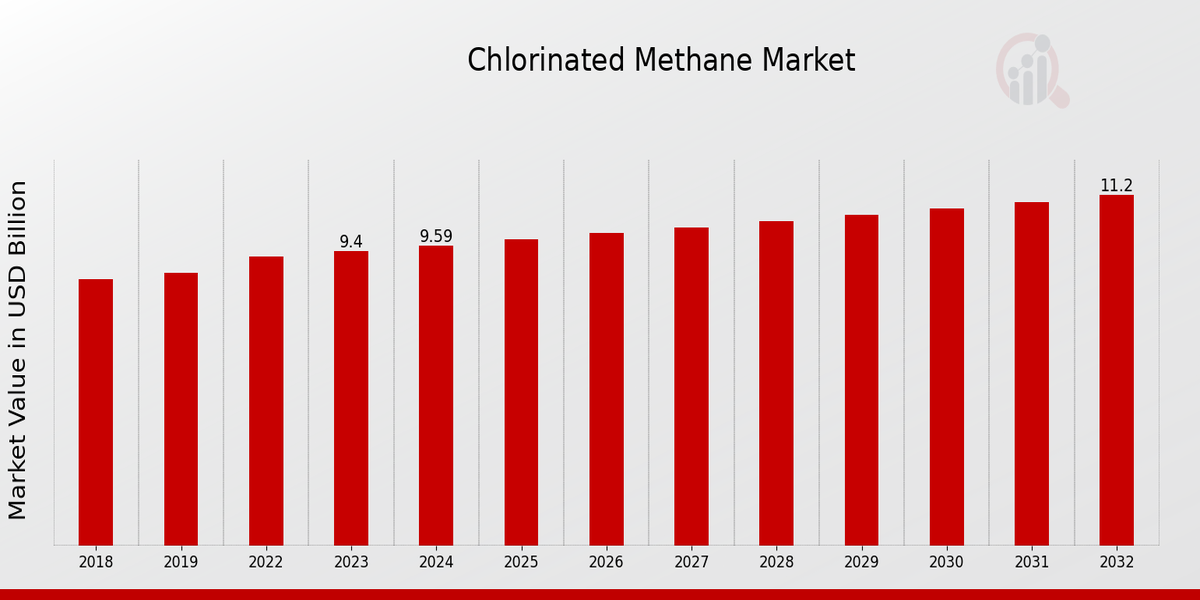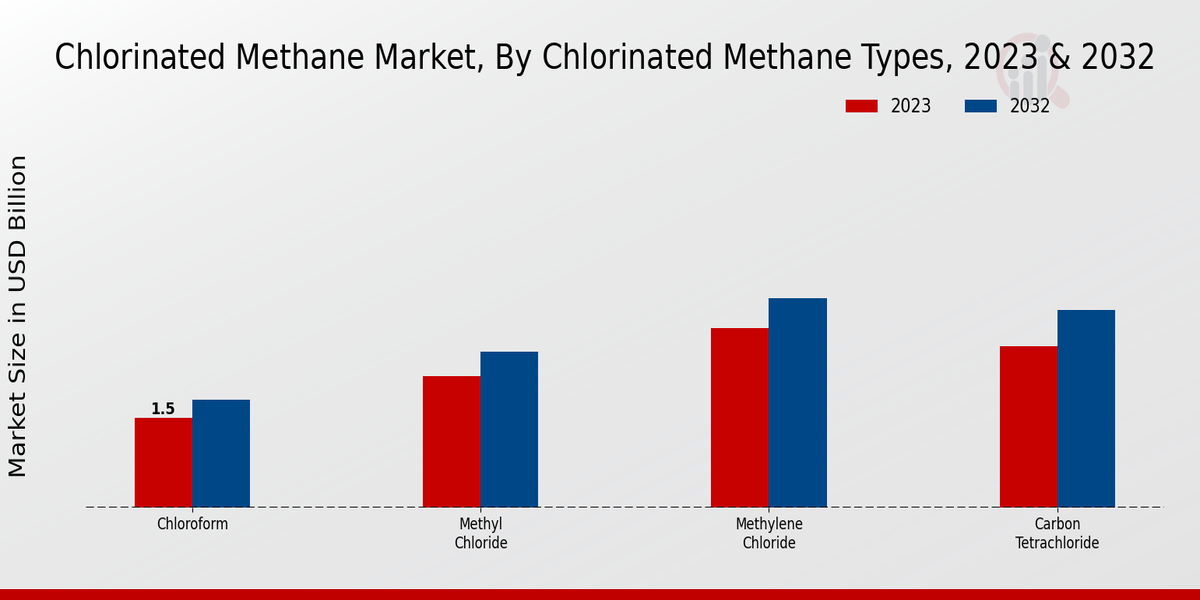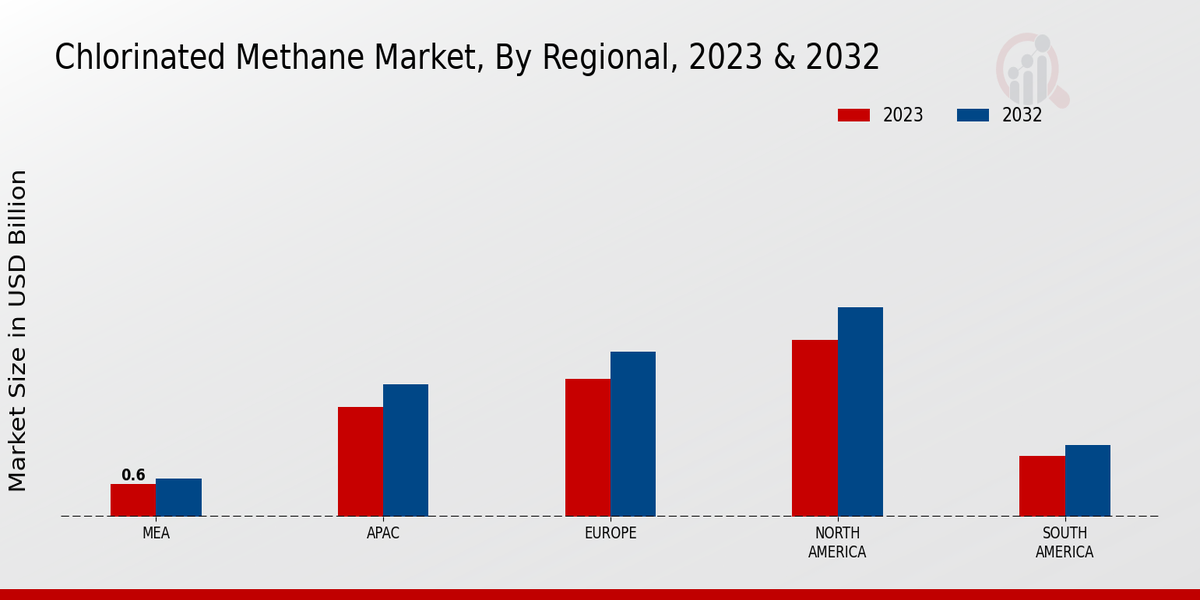Global Chlorinated Methane Market Overview
The chlorinated methane market size was estimated at 9.77(USD billion) in 2024. The chlorinated methane industry is expected to grow from 9.97(USD billion) in 2025 to 11.87 (USD billion) by 2034. The chlorinated methane market CAGR (growth rate) is expected to be around 2.00% during the forecast period (2025 - 2034).
Key Chlorinated Methane Market Trends Highlighted
The chlorinated methane market is witnessing significant growth, driven by various factors, including rising demand from the chemical industry, increasing applications in pharmaceuticals, and the expanding use of chlorinated solvents in various manufacturing processes.
The versatility of chlorinated methane, particularly in the production of agrochemicals and other specialty chemicals, has further solidified its importance in numerous sectors. Additionally, regulatory support for the use of certain chlorinated compounds in industrial applications is acting as a catalyst for market expansion.
Opportunities in the market are primarily focused on the development of more environmentally friendly procedures for the production and use of chlorinated methane. As industries increasingly prioritize sustainability, exploring alternatives and advanced technologies for chlorinated methane manufacturing can provide competitive advantages.
Furthermore, the potential for expanding into emerging economies presents a valuable opportunity for market players. These regions are seeing a surge in industrial activities, thus contributing to a higher demand for various chemical segments.
Recent trends indicate a shift toward innovation and diversification within the chlorinated methane market. Companies are dedicating resources to research and development to enhance product offerings and improve efficiency in production methods.
There is also an observable trend towards strategic collaborations and partnerships aimed at strengthening supply chains and enhancing competitive positioning in the market. As consumer awareness regarding environmental impacts grows, stakeholders are likely to focus more on sustainable practices, which will shape the future landscape of the chlorinated methane industry.

Source: Primary Research, Secondary Research, MRFR Database and Analyst Review
Chlorinated Methane Market Drivers
Increasing Demand from Chemical Manufacturing
The chlorinated methane market is witnessing significant growth driven by the increasing demand from chemical manufacturing sectors.
Chlorinated methane is a vital precursor for numerous chemical syntheses, including the production of various agrochemicals, pharmaceuticals, and other specialty chemicals. As industrial activities grow ly, there is a marked rise in the need for efficient and effective chemical processes that utilize chlorinated methane as key components.
The widespread use of chlorinated methane in producing solvents, refrigerants, and intermediates for many chemical processes highlights its essential role in industrial applications. As the population increases, so does the demand for food, healthcare, and consumer products, prompting chemical manufacturers to ramp up production levels.
This uptick in manufacturing not only creates a consistent demand for chlorinated methane but also encourages innovations and developments in production processes to enhance yield and minimize environmental impact.
With the advancements in chemical engineering, the role of chlorinated methane becomes even more pivotal, amplifying its importance in the market. Consequently, the synergy between industrial growth and the demand for chlorinated methane signifies a promising trajectory for the chlorinated methane market, leading to sustained market growth in the coming years.
Technological Advancements in Production Methods
Technological advancements in production methods are fueling growth in the chlorinated methane market. Manufacturers are continuously innovating and optimizing processes to enhance efficiency, reduce costs, and minimize environmental impact.
Innovations such as improved distillation techniques and more eco-friendly reaction pathways contribute to higher yields and refined product quality. This enhances the overall competitiveness of chlorinated methane in various applications, supporting the market's expansion.
The drive for sustainability and environmental responsibility is further promoting investment in advanced technologies.
Regulatory Developments Supporting Chemical Usage
The regulatory developments supporting chemical usage play a crucial role in the chlorinated methane market. Governments are recognizing the importance of chlorinated methane in various applications while enforcing regulations that promote safe handling and usage.
New frameworks and guidelines are consistently being established to ensure that industries can utilize chlorinated methane efficiently, fostering an environment conducive to market growth. These supportive regulations can facilitate access to key markets and boost consumer confidence.
Chlorinated Methane Market Segment Insights
Chlorinated Methane Market Chlorinated Methane Types Insights
Among the various Chlorinated Methane Types, four categories are particularly noteworthy: Methyl Chloride, Methylene Chloride, Chloroform, and Carbon Tetrachloride.
Methyl Chloride was valued at 2.2 USD billion in 2023, growing to 2.6 USD billion by 2032, marking a significant contribution to the overall market as it serves crucial roles in the production of other chemicals and applications in the agriculture sector, wherein it is vital for manufacturing pesticides and fungicides.
Methylene Chloride, with market valuation of 3.0 USD billion expected to rise to 3.5 USD billion, dominates the market segment due to its widespread use in paint strippers, solvents, and as a degreaser in various industrial settings, reflecting its importance in diverse fields including automotive and manufacturing.
Chloroform was also noteworthy, positioned with a valuation of 1.5 USD billion in 2023 and projected to increase to 1.8 USD billion, primarily utilized in laboratories and the pharmaceutical industry for its efficacy as a solvent and in the synthesis of compounds, indicating its crucial role in research and development activities.
Moreover, Carbon Tetrachloride, valued at 2.7 USD billion in 2023 and expected to grow to 3.3 USD billion, has its significance derived from its historical use as a refrigerant and its applications in cleaning processes, despite facing regulatory challenges in recent years due to environmental concerns.
The various dynamics between these Chlorinated Methane Types not only showcase their individual contributions but also underline the broader trends in the chlorinated methane market; the demand for environmentally compliant alternatives drives considerable innovation within these segments.
With specific applications and regulatory landscapes surrounding each type, the market will likely continue to evolve, paving the way for future opportunities and challenges as industries adapt to changing environmental standards and innovations in chemical processing.
By analyzing this segmentation, stakeholders can gain insights into market growth, technological advancements, and the overall competitive landscape that shapes the chlorinated methane market data.

Source: Primary Research, Secondary Research, MRFR Database and Analyst Review
Chlorinated Methane Market Application Areas Insights
The solvents segment plays a crucial role due to its widespread usage in paint thinners, adhesives, and coatings, making it a significant contributor to market revenue.
Refrigerants, essential in cooling technologies and ensuring refrigeration efficiency, hold a prominent position within the market framework. Chemical intermediates are key for the production of diverse chemicals, showcasing their importance in facilitating chemical synthesis processes.
Extraction agents, critical for isolating specific compounds during chemical processes, support the growing demand in the pharmaceutical industry, which itself is a major driver of the chlorinated methane market.
This market is characterized by steady growth, driven by increasing industrial applications and advances in chemical manufacturing technologies. Factors such as regulatory challenges and environmental concerns regarding the usage of chlorinated compounds present challenges to the market.
However, opportunities abound in developing eco-friendly alternatives and innovative applications that can enhance efficiency and reduce environmental impact. As such, the market dynamics are influenced by evolving regulations and technological advancements that create a roadmap for future growth.
Chlorinated Methane Market End-Use Industries Insights
Significant demand arises from the pharmaceutical sector, where chlorinated methane serves as a crucial solvent and intermediate in drug formulation, ensuring effective drug delivery systems.
The Automotive industry also plays a key role, relying on chlorinated methane in the production of adhesives and insulating materials, contributing to sustainable vehicle designs. Additionally, the Chemicals industry remains a major driver, as chlorinated methane is essential for synthesizing various chemicals and solvents used in manufacturing processes.
The Construction industry benefits from this market through the use of chlorinated methane in flame retardants and sealants, promoting safety and durability in structures. Lastly, the Electronics industry utilizes chlorinated methane for its applications in cleanroom environments and component manufacturing, emphasizing its importance in innovative technology.
Overall, these industries significantly contribute to the chlorinated methane market statistics, creating opportunities for increased market penetration and technological advancements within the sector.
Chlorinated Methane Market Purity Levels Insights
The chlorinated methane market encompasses various purity levels that play a significant role in defining its dynamics.
Purity levels are crucial in segmenting the market, with each level serving distinct industries and uses. High-purity chlorinated methane often finds its application in pharmaceuticals and specialty chemicals, driving its importance in the market. On the other hand, medium and low purity levels continue to cater to industries such as chemicals and solvents, which require these products for less sensitive applications.
The market growth in the purity levels segment is driven by increasing industrial applications and a growing demand for specialized chemical products. Nonetheless, challenges such as regulatory standards and environmental concerns may impact on certain purity levels' production and use, requiring advancements in manufacturing processes.
Overall, the segmentation of the chlorinated methane market into purity levels aids in understanding market trends, growth drivers, and potential opportunities, further informing strategic planning and decision-making within the industry.
Chlorinated Methane Market Packaging Types Insights
The segmentation of this market includes different packaging formats such as Drum, Bottle, Bulk, and Cylinder, each serving specific customer needs and distribution channels.
Drums are often favored for their capacity and ease of handling in industrial applications, while bottles cater to smaller-scale users looking for convenience. The bulk segment dominates due to increasing demand for large quantities in manufacturing processes, reflecting the growth drivers in chemical production.
Cylinders are also significant, particularly in applications requiring high-pressure environments. As the chlorinated methane market experiences growth, the diversification in packaging types plays a crucial role in meeting various industry requirements.
Adapting to changing customer preferences while maintaining compliance with safety standards presents both challenges and opportunities for market players. Overall, understanding the dynamics of this segmentation provides valuable insights into the overall chlorinated methane landscape.
Chlorinated Methane Market Regional Insights
The chlorinated methane market is witnessing notable regional segmentation with varied contributions across different areas. In 2023, North America emerged as the leading region, holding a market value of 3.2 USD billion, attributed to its well-established industrial base and growing applications in pharmaceuticals and agrochemicals.
Europe followed closely with a valuation of 2.5 USD billion, driven by stringent regulations aimed at chemical safety and sustainable practices. Meanwhile, Asia Pacific stood significant with a value of 2.0 USD billion, reflecting rapid industrialization and increasing demand from sectors such as electronics and textiles.
South America, valued at 1.1 USD billion, showed potential for growth driven by expanding agricultural activities, while the Middle East and Africa, valued at 0.6 USD billion, faced challenges yet have opportunities for development in the chemical sector.
This diverse regional distribution underscores the varying market dynamics, growth drivers, and potential challenges unique to each region within the chlorinated methane market.

Source: Primary Research, Secondary Research, MRFR Database and Analyst Review
Chlorinated Methane Market Key Players and Competitive Insights
The chlorinated methane market has garnered significant attention due to its diverse applications spanning across several industrial sectors. The competitive landscape is characterized by the presence of several prominent players who are investing in research and development to enhance their product offerings and cater to the evolving demands of various end-user industries.
Companies are focused on expanding their production capacities, optimizing their supply chains, and improving sustainability practices. This competitive environment encourages innovation and strategic partnerships, driving growth and operational efficiencies while addressing regulatory challenges and consumer preferences for safer chemical products.
Chemours, as a key player in the chlorinated methane market, positions itself with robust product development strategies and a commitment to operational excellence. The company leverages its extensive expertise in chemical manufacturing to deliver high-quality chlorinated methane products that meet stringent industry specifications.
Chemours has established a strong market presence by adopting innovative technologies and driving sustainable practices, which resonate well with modern environmental standards. The company emphasizes its capability to serve a diverse range of applications, thus enhancing its competitive edge and establishing a loyal customer base.
This strategic focus on quality and service has significantly bolstered its role in the chlorinated methane segment, making it a formidable competitor in the arena. China National Chemical Corporation has solidified its position in the chlorinated methane market through strategic expansion and investment in production capabilities.
With a comprehensive portfolio of chlorinated methane products, the company has harnessed its extensive manufacturing infrastructure to meet the increasing demand from various industrial applications.
China National Chemical Corporation benefits from economies of scale and strong supply chain logistics, which allow it to maintain competitive pricing while ensuring product availability. Furthermore, the corporation’s emphasis on research and development plays a pivotal role in enhancing its product offerings, enabling it to innovate and adapt to changing market conditions.
The company’s commitment to maintaining high-quality standards and compliance with international regulations has also strengthened its reputation, making it a significant player in this competitive marketplace.
Key Companies in the chlorinated methane market Include
- Chemours
- China National Chemical Corporation
- Huntsman Corporation
- Albemarle Corporation
- Wacker Chemie
- Occidental Petroleum
- Lanxess
- INEOS
- Eastman Chemical
- Koch Industries
- BASF
- Mitsubishi Chemical
- Tosoh Corporation
- ShinEtsu Chemical
- Solvay
Chlorinated Methane Market Developments
Recent developments in the chlorinated methane market highlight a growing focus on sustainable practices and regulatory compliance. As industries adapt to stringent environmental regulations, there is an increasing shift towards cleaner production processes and alternatives to traditional chlorinated compounds.
Innovations in production technologies are aimed at reducing the environmental impact associated with chlorinated methane manufacturing. Additionally, market participants are engaging in strategic partnerships and collaborations to enhance their product offerings and expand their market presence.
As the demand for chlorinated methane, such as dichloromethane and chloroform, continues to rise across sectors like pharmaceuticals, agrochemicals, and solvents, companies are investing in research and development to create more efficient and eco-friendly products.
Furthermore, recent geopolitical events have affected supply chains, prompting stakeholders to reassess sourcing strategies and explore region-specific opportunities to mitigate risks. The overall outlook suggests a cautious yet optimistic trajectory for the chlorinated methane market, driven by innovation, regulatory pressures, and changing consumer preferences.
Chlorinated Methane Market Segmentation Insights
Chlorinated Methane Market Chlorinated Methane Types Outlook
- Methyl Chloride
- Methylene Chloride
- Chloroform
- Carbon Tetrachloride
Chlorinated Methane Market Application Areas Outlook
- Solvents
- Refrigerants
- Chemical Intermediates
- Extraction Agents
- Pharmaceuticals
Chlorinated Methane Market End-Use Industries Outlook
- Pharmaceutical
- Automotive
- Chemicals
- Construction
- Electronics
Chlorinated Methane Market Purity Levels Outlook
- Low Purity
- Medium Purity
- High Purity
Chlorinated Methane Market Packaging Types Outlook
- Drum
- Bottle
- Bulk
- Cylinder
Chlorinated Methane Market Regional Outlook
- North America
- Europe
- South America
- Asia Pacific
- Middle East and Africa
| Report Attribute/Metric |
Details |
| Market Size 2024 |
9.77(USD billion) |
| Market Size 2025 |
9.97(USD billion) |
| Market Size 2034 |
11.87(USD billion) |
| Compound Annual Growth Rate (CAGR) |
2.00% (2025 - 2034) |
| Report Coverage |
Revenue Forecast, Competitive Landscape, Growth Factors, and Trends |
| Base Year |
2024 |
| Market Forecast Period |
2025 - 2034 |
| Historical Data |
2020 - 2024 |
| Market Forecast Units |
USD billion |
| Key Companies Profiled |
Chemours, China National Chemical Corporation, Huntsman Corporation, Albemarle Corporation, Wacker Chemie, Occidental Petroleum, Lanxess, INEOS, Eastman Chemical, Koch Industries, BASF, Mitsubishi Chemical, Tosoh Corporation, ShinEtsu Chemical, Solvay |
| Segments Covered |
Chlorinated Methane Types, Application Areas, End-Use Industries, Purity Levels, Packaging Types, Regional |
| Key Market Opportunities |
Increasing demand for agrochemicals Expanding pharmaceutical applications Growth in solvent utilization Rise in chemical manufacturing Strategic partnerships and collaborations |
| Key Market Dynamics |
Regulatory challenges Rising industrial demand Technological advancements Environmental concerns Market consolidation trends |
| Countries Covered |
North America, Europe, APAC, South America, MEA |
Frequently Asked Questions (FAQ) :
The chlorinated methane market is expected to reach a value of 11.87 USD billion by 2034.
The market is projected to grow at a CAGR of 2.00% from 2025 to 2034.
North America holds the largest market share in 2023, valued at 3.2 USD billion.
The Methyl Chloride segment was valued at 2.2 USD billion in 2023.
The European market is expected to grow from 2.5 USD billion in 2023 to 3.0 USD billion by 2032.
Major players in the market include Chemours, Huntsman Corporation, and BASF.
The Carbon Tetrachloride segment is expected to reach 3.3 USD billion by 2032.
The Methylene Chloride segment was valued at 3.0 USD billion in 2023.
Challenges include regulatory restrictions and environmental concerns.
The APAC region is projected to grow to 2.4 USD billion by 2032 from a valuation of 2.0 USD billion in 2023.

















